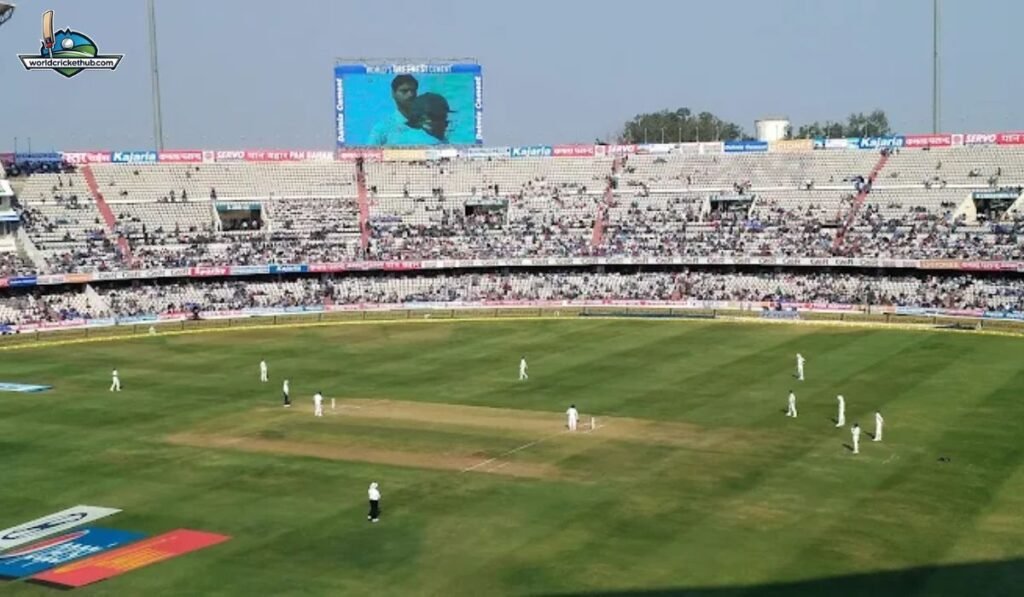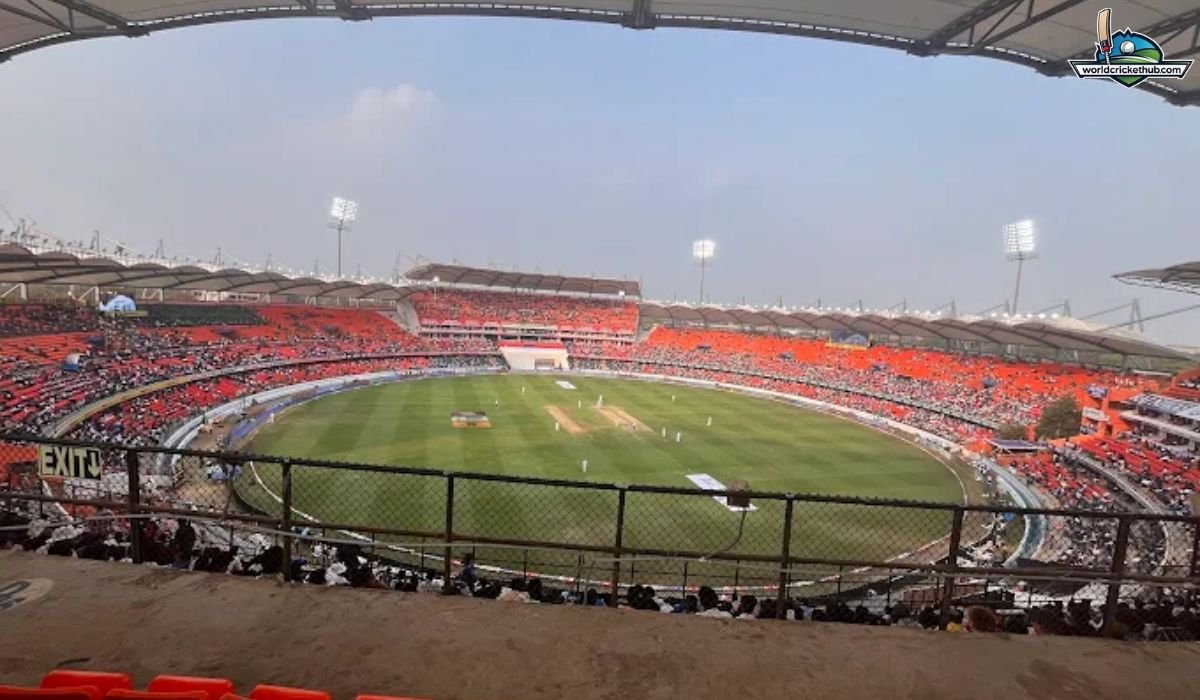Rajiv Gandhi International Stadium pitch report – The Rajiv Gandhi International Stadium, which is located in Hyderabad (Uppal), is one of the prominent cricketing venues in India. The pitch of this stadium offers fair play between bat and ball. It is generally balanced in nature, and the surface is batting-friendly. Especially in the initial stages of the match, the pitch provides a good bounce and pace that allows batters to play their stroke easily. This pitch is a favourite of power hitters, and this is why many high-scoring encounters have been made possible in this stadium, both domestically and internationally.
However, the pitch slows down as the match continues, and this is when spinners come into play. Particularly in the second half of the match, spinners can get some grip and eventually, wickets. Moreover, this changing nature of the pitch makes it challenging for the batter to maintain the momentum throughout the match.
The stadium is also known as the home ground for the Sunrisers Hyderabad in the Indian Premier League (IPL). Due to their familiarity with the pitch, they know how to give both batter and bowlers a chance to make an impact. Further, dew is also an important factor in the stadium, especially in night matches. This also influences the toss-winning captain’s decision to bowl or bat. With this, let us discuss the Rajiv Gandhi International Stadium pitch report across all formats and games.
How Does the Rajiv Gandhi International Stadium Pitch Behave?
The pitch of Rajiv Gandhi International Stadium offers a balanced surface and fair play between the ball and bat. In the initial stages of the match, the pitch is considered batting-friendly, allowing batters to score good runs. However, as the match continues, spinners get the help – they can get a grip of the ball and take some crucial wickets. Not to forget that the dew factor also plays a crucial role, especially during night matches, thus favouring the chasing team. Overall, the changing nature of the pitch ensures that both batters and bowlers can play a good game, often leading to thrilling encounters.
Rajiv Gandhi International Stadium Ground Overview
The Rajiv Gandhi International Stadium is located the Hyderabad, Telangana. The stadium serves as the home ground for the Hyderabad Cricket Association (HCA) and the IPL team Sunrisers Hyderabad. It has hosted several domestic and international matches, witnessing some memorable records and performances.
- Capacity – The stadium can host 55,000 spectators at once. This makes the stadium one of the biggest grounds in India.
- Ends – There are two bowling ends, named Pavilion End and the North End (renamed as V.V.S. Laxman End)
- Architecture – The architecture of the stadium ensures an unobstructed view for the spectators.
- Outfield – The outfield of this stadium is green and fast. This allows the ball to travel quickly to boundaries, contributing to high-scoring matches.
- Drainage – The venue is equipped with a sub-soil drainage system. This allows the water to recover quickly, minimising delays and cancellations.
Pitch Behaviour in Tests
The pitch of Rajiv Gandhi International Stadium in tests offers a dynamic surface, which evolves over five days. In the early days, the pitch favoured batters, making it a batsman’s paradise. Especially on the first two days, it offers a hard and flat surface that makes batting easier. Fast bowlers may get initial help, but it’s not for too long. Moreover, the role of spinners comes into play from the third day onwards, as the pitch begins to develop cracks, offering grip and turn to bowlers. With this, batting becomes difficult on the fourth and fifth days. This is why the toss-winning captain chooses to bat first in test matches at this ground.
ODI Pitch Behaviour
The pitch of Rajiv Gandhi International Stadium in the ODIs offers a balanced surface, favouring batsmen initially. With bounce and pace, batters can score good runs in the first innings. Pacers can definitely restrict them, as the pitch favours them, too, initially. As the match continues, the pitch develops cracks and makes it easier for spinners to play their game and challenging for batters to chase the runs, especially in day matches. The dew factor is also one of the major factors, especially in night matches, which favors the team batting second. The dew factor also makes it difficult for spinners to get a grip on the ball. This is why the toss decision at this stadium is crucial.
T20I Pitch Behaviour
The Rajiv Gandhi International Stadium pitch in the T20Is provides an even surface, with an edge towards batsmen early on. With even pace and bounce, the batters can make good runs in the first innings. Pacers can surely hold them back, as the pitch is in their favour, too, early on. As the game goes on, the pitch gets cracks and allows spinners to play their game easily, and tough for the batters to chase the runs, especially in day matches. The dew factor is another of the key factors, particularly in night matches, that works in favor of the team batting second.
Toss and Match Strategy Summary

The toss at the Rajiv Gandhi International Stadium is a crucial factor. However, generally, the toss-winning captain chooses to bowl first. This decision is largely influenced by the dew factor, which is prominent in the night matches. The dew, especially in the second innings, makes the ball wet, making it difficult for bowlers and easy for batters to chase runs. This gives the chasing team an advantage, as the pitch becomes batting-friendly.
Also, the statistics of this venue show that the team batting second has a higher chance of winning the match. For the team bowling first, their strategy is to limit the batters from scoring high runs by taking wickets. For the team batting first, their strategy is to make as many runs as possible. Moreover, the batsmen should start hitting from the start as the pitch becomes slow later on, making it challenging for new batters to settle. Thus, winning the toss becomes crucial for any captain at this venue.
Historical Games and Significant Individual Performances
The Rajiv Gandhi International Stadium has witnessed several memorable matches and individual performances. Let us take a look at some of them.
Notable Moments
It was the year 2018 when India registered a 10-wicket victory against the West Indies at the Rajiv Gandhi International Stadium. It was a team performance, which was led by Umesh Yadav. Also, this stadium hosted two IPL finals, both of which were won by the Mumbai Indians, in 2017 and 2019
Significant Individual Performances
In its history, the stadium has seen many memorable and record-breaking innings or knocks. Some of the most memorable ones are Brendon McCullum’s blistering hundred and Cheteshwar Pujara’s double hundred. Also, we should not forget the 204-run knock of Virat Kohli in 2017. Further, this stadium has also seen Alzarri Joseph’s spell of 6 for 12, and a 208-run knock of Shubman Gill. These are some of the noteworthy performances witnessed at this stadium.
Conclusion
In summary, we can say that the Rajiv Gandhi International Stadium is a cricketing ground with historical significance, which provides an abundance of records and achievements. The stadium’s pitch is a dream for batsmen and difficult for bowlers, which produces spectacular high-scoring matches finishing with plenty of boundaries. The key factor in the stadium is the dew, which makes spinners struggle in gripping the ball and provides more assistance to the team that is chasing the runs. Therefore, the motto is easy at the Rajiv Gandhi International Stadium – win the toss and bowl first.
Learn More: Dharamshala Cricket Stadium || Sheikh Zayed Stadium || Pallekele International Cricket Stadium


